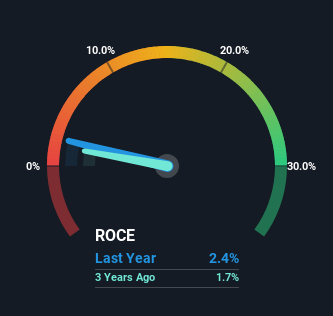- Hong Kong
- /
- Gas Utilities
- /
- SEHK:392
Returns At Beijing Enterprises Holdings (HKG:392) Appear To Be Weighed Down
What are the early trends we should look for to identify a stock that could multiply in value over the long term? Typically, we'll want to notice a trend of growing return on capital employed (ROCE) and alongside that, an expanding base of capital employed. If you see this, it typically means it's a company with a great business model and plenty of profitable reinvestment opportunities. In light of that, when we looked at Beijing Enterprises Holdings (HKG:392) and its ROCE trend, we weren't exactly thrilled.
Understanding Return On Capital Employed (ROCE)
Just to clarify if you're unsure, ROCE is a metric for evaluating how much pre-tax income (in percentage terms) a company earns on the capital invested in its business. Analysts use this formula to calculate it for Beijing Enterprises Holdings:
Return on Capital Employed = Earnings Before Interest and Tax (EBIT) ÷ (Total Assets - Current Liabilities)
0.024 = HK$4.1b ÷ (HK$225b - HK$54b) (Based on the trailing twelve months to June 2023).
Therefore, Beijing Enterprises Holdings has an ROCE of 2.4%. In absolute terms, that's a low return and it also under-performs the Gas Utilities industry average of 8.2%.
View our latest analysis for Beijing Enterprises Holdings

Above you can see how the current ROCE for Beijing Enterprises Holdings compares to its prior returns on capital, but there's only so much you can tell from the past. If you're interested, you can view the analysts predictions in our free report on analyst forecasts for the company.
So How Is Beijing Enterprises Holdings' ROCE Trending?
Over the past five years, Beijing Enterprises Holdings' ROCE and capital employed have both remained mostly flat. It's not uncommon to see this when looking at a mature and stable business that isn't re-investing its earnings because it has likely passed that phase of the business cycle. So unless we see a substantial change at Beijing Enterprises Holdings in terms of ROCE and additional investments being made, we wouldn't hold our breath on it being a multi-bagger. This probably explains why Beijing Enterprises Holdings is paying out 35% of its income to shareholders in the form of dividends. Unless businesses have highly compelling growth opportunities, they'll typically return some money to shareholders.
In Conclusion...
We can conclude that in regards to Beijing Enterprises Holdings' returns on capital employed and the trends, there isn't much change to report on. And investors appear hesitant that the trends will pick up because the stock has fallen 21% in the last five years. Therefore based on the analysis done in this article, we don't think Beijing Enterprises Holdings has the makings of a multi-bagger.
If you want to know some of the risks facing Beijing Enterprises Holdings we've found 2 warning signs (1 is concerning!) that you should be aware of before investing here.
While Beijing Enterprises Holdings may not currently earn the highest returns, we've compiled a list of companies that currently earn more than 25% return on equity. Check out this free list here.
Valuation is complex, but we're here to simplify it.
Discover if Beijing Enterprises Holdings might be undervalued or overvalued with our detailed analysis, featuring fair value estimates, potential risks, dividends, insider trades, and its financial condition.
Access Free AnalysisHave feedback on this article? Concerned about the content? Get in touch with us directly. Alternatively, email editorial-team (at) simplywallst.com.
This article by Simply Wall St is general in nature. We provide commentary based on historical data and analyst forecasts only using an unbiased methodology and our articles are not intended to be financial advice. It does not constitute a recommendation to buy or sell any stock, and does not take account of your objectives, or your financial situation. We aim to bring you long-term focused analysis driven by fundamental data. Note that our analysis may not factor in the latest price-sensitive company announcements or qualitative material. Simply Wall St has no position in any stocks mentioned.
About SEHK:392
Beijing Enterprises Holdings
Through its subsidiaries, engages in the gas, water, environmental, brewery, and other businesses in Mainland China, Germany, and internationally.
Undervalued with proven track record.
Similar Companies
Market Insights
Community Narratives



